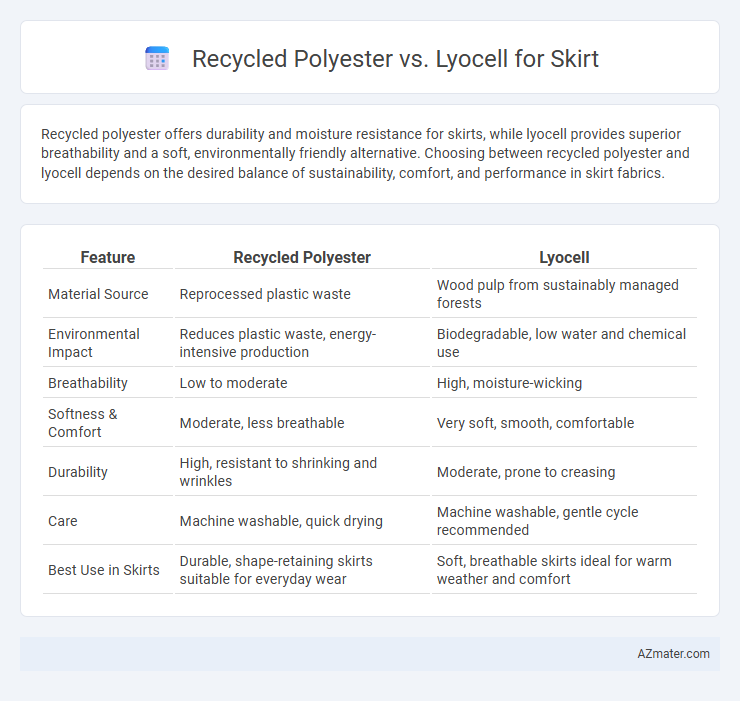Recycled polyester offers durability and moisture resistance for skirts, while lyocell provides superior breathability and a soft, environmentally friendly alternative. Choosing between recycled polyester and lyocell depends on the desired balance of sustainability, comfort, and performance in skirt fabrics.
Table of Comparison
| Feature | Recycled Polyester | Lyocell |
|---|---|---|
| Material Source | Reprocessed plastic waste | Wood pulp from sustainably managed forests |
| Environmental Impact | Reduces plastic waste, energy-intensive production | Biodegradable, low water and chemical use |
| Breathability | Low to moderate | High, moisture-wicking |
| Softness & Comfort | Moderate, less breathable | Very soft, smooth, comfortable |
| Durability | High, resistant to shrinking and wrinkles | Moderate, prone to creasing |
| Care | Machine washable, quick drying | Machine washable, gentle cycle recommended |
| Best Use in Skirts | Durable, shape-retaining skirts suitable for everyday wear | Soft, breathable skirts ideal for warm weather and comfort |
Introduction to Sustainable Fabrics: Recycled Polyester and Lyocell
Recycled polyester and lyocell represent two leading sustainable fabrics used in eco-friendly skirts, each offering distinct environmental benefits. Recycled polyester, made from post-consumer plastic bottles, reduces landfill waste and lowers carbon emissions compared to virgin polyester. Lyocell, derived from sustainably sourced wood pulp through a closed-loop process, provides biodegradability and breathability, making it an ideal choice for sustainable fashion.
What Is Recycled Polyester?
Recycled polyester is a sustainable fabric made from post-consumer plastic bottles and industrial polyester waste, reducing landfill and ocean pollution. It offers durability, moisture-wicking properties, and resistance to wrinkles, making it ideal for skirts that require long-lasting wear. This eco-friendly material helps lower carbon emissions compared to virgin polyester, contributing positively to environmental conservation.
What Is Lyocell?
Lyocell is a sustainable fiber made from cellulose found in wood pulp, produced through a solvent-spinning process that is eco-friendly and biodegradable. Compared to recycled polyester, which is derived from melted plastic waste, Lyocell offers superior breathability, moisture-wicking properties, and a softer feel, making it ideal for skirts. Its renewable sourcing and closed-loop manufacturing contribute to lower environmental impact, appealing to environmentally conscious fashion consumers.
Environmental Impact: Recycled Polyester vs Lyocell
Recycled polyester, made from post-consumer plastic waste, significantly reduces landfill and ocean pollution while lowering carbon emissions compared to virgin polyester production. Lyocell is derived from sustainably sourced wood pulp and utilizes a closed-loop solvent process that recycles water and chemicals, minimizing environmental harm and promoting biodegradability. Both materials contribute to sustainable fashion; however, lyocell offers superior biodegradability and a lower ecological footprint in water usage and chemical impact.
Comfort and Wearability for Skirts
Recycled polyester offers durability and moisture-wicking properties, making skirts resistant to wrinkles and quick-drying for active wear. Lyocell provides superior breathability and a soft, silky texture that enhances comfort during extended wear. For skirts, Lyocell's natural fiber content helps regulate temperature and reduces irritation, while recycled polyester ensures strength and shape retention.
Durability and Longevity Comparison
Recycled polyester offers superior durability and resistance to abrasion, making it highly suitable for skirts intended for frequent wear and washing cycles. Lyocell, while eco-friendly and soft, tends to have lower tensile strength and may show signs of wear or pilling faster than recycled polyester over time. For longevity, recycled polyester skirts maintain shape and color retention better, ensuring extended garment life despite repeated use.
Moisture Management and Breathability
Recycled polyester excels in moisture management by quickly wicking sweat away from the skin, making it ideal for active wear skirts requiring rapid drying. Lyocell offers superior breathability due to its natural cellulose fiber structure, allowing better air circulation and moisture absorption for enhanced comfort in warmer conditions. Choosing between the two hinges on the desired balance between quick-drying performance and natural airflow in skirt fabrics.
Aesthetic Qualities: Drape, Color, and Texture
Recycled polyester offers a smooth texture and vibrant color retention, creating skirts with a glossy finish and structured drape that holds pleats and folds well. Lyocell features a soft, matte texture with excellent breathability and fluid drape, resulting in skirts that flow naturally and showcase rich, muted colors. The choice between these fibers impacts the skirt's aesthetic appeal, balancing synthetic sheen and durability against natural softness and elegant movement.
Price Points and Market Availability
Recycled polyester skirts generally offer lower price points due to the cost-efficient production process and widespread availability of recycled materials, making them accessible in mass-market retail stores. Lyocell skirts, derived from sustainably sourced wood pulp, tend to be priced higher because of the eco-friendly closed-loop manufacturing method and limited supply chains focused on sustainable fashion. Market availability for recycled polyester skirts is extensive worldwide, while lyocell skirts are more commonly found in niche and premium eco-conscious brands.
Which Fabric Is Better for Skirts?
Recycled polyester offers high durability, moisture-wicking properties, and excellent shape retention, making it a practical choice for skirts that require long-lasting wear and easy maintenance. Lyocell, derived from sustainably sourced wood pulp, provides superior breathability, softness, and a luxurious drape, ideal for skirts emphasizing comfort and eco-friendly fashion. Choosing between recycled polyester and lyocell depends on whether durability and low maintenance or natural fiber comfort and biodegradability are prioritized for the skirt's intended use.

Infographic: Recycled polyester vs Lyocell for Skirt
 azmater.com
azmater.com